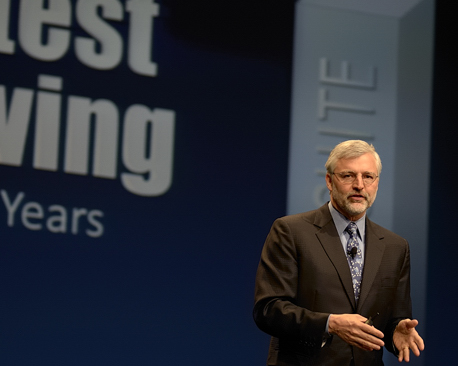NetSuite under the microscope

Cloud-based ERP vendor, NetSuite held its first ever user conference, called SuiteWorld 2011, this week in San Francisco. The event brought together 1,800 users, partners, press, and influencers (bloggers and analysts) to see and hear the NetSuite story.
To get a flavor for the NetSuite's current state of affairs I attended keynotes and analyst briefings, joined a session on change management, and participated on a panel that included lots of interaction with customers. In addition, I had private, one-on-one discussions with a number of NetSuite executives, including:
- Zach Nelson - CEO
- Evan Goldberg - Founder and Chief Technical Officer
- David Downing - Senior Vice President of Marketing
- Tim Dilley - Chief Customer Officer
- Ron Gill - Chief Financial Officer
Here are several initial impressions from the event.
Upmarket strategy. NetSuite further articulated its strategy to sell into large enterprise organizations. During an analyst session, Zach Nelson explained the importance of larger customers by noting that NetSuite revenue from companies with over one-thousand employees is growing. He also showed a trajectory chart explaining that NetSuite's average selling price in 2001 was $447, while today it is $40,000. During the same meeting, Zach added that NetSuite has a "surround strategy," using two-tier ERP to gain entrance to large organizations.
Key components of the upmarket strategy include:
- Growing two-tier ERP, in which NetSuite sells to large organizations with multiple subsidiaries or regional operating units. Although these large enterprises may use on-premise ERP from Oracle or SAP at the parent company level, NetSuite's OneWorld product provides subsidiary organizations with a cloud alternative.
- Implementation and consulting partnerships with professional services firms such as Accenture, RSM McGladrey, and Baker Tilly. These relationships expand NetSuite's footprint in the mid-market while opening the door to division and departmental implementations at much larger organizations. During an informal conversation, Accenture's Partner responsible for SaaS, Saideep Raj, told me that two-tier ERP is real: "Our clients are doing this today."
- Integration partnerships, with companies such as Informatica and Celigo, to help ease data transfer between parent organization and subsidiaries in two-tier ERP implementations.
- Emphasizing vertical markets, for example, the specific needs of wholesale and distribution companies. During the analyst session, Zach Nelson explained that larger organizations in these areas possess sophisticated ERP requirements, which drives NetSuite adoption.
These components of strategy have helped fuel NetSuite's growth in the mid-market and at the division level of large companies.
Whether NetSuite can make the leap from divisional solution to large-enterprise success remains to be seen. As NetSuite develops core solutions for larger organizations, it will face fierce competition from the largest, most established ERP players. Although these competitive wars have yet to be fought, the storm clouds of enterprise battle are drawing closer.
Social business integration. NetSuite announced a new capability, called SuiteSocial, and partnerships with social software vendors, Yammer and Qontext. The company describes SuiteSocial this way:
With SuiteSocial, users can follow records of interest in NetSuite, and as important activities and updates occur, SuiteSocial content is automatically generated which may then be syndicated to an external social stream or feed.
Using SuiteSocial, Yammer creates an activity stream of information, based on customer records, that includes all associated transaction data. Over time, NetSuite plans to expand the data available through SuiteSocial.
While Yammer creates an activity stream within NetSuite, Qontext embeds collaboration tools, such as discussions, directly within the NetSuite application.
By embedding activity streams based on data in the system with collaboration capabilities, NetSuite makes a reasonable entrance into the social business world. A few observations are in order:
- The SuiteSocial announcement deepens the trend of social business software growth in the enterprise. ERP is the definitive enterprise application and social integration is becoming an essential feature.
- User adoption remains a concern; business processes must change and evolve for users to take full advantage of the social software capabilities built into systems such as ERP.
- Today, NetSuite presents its social features as individual tabs in the user interface. Over time, I want to see how the company integrates social software more thoroughly into the fabric of its user interface and processes.
Rapid implementation. NetSuite announced that fast-growing group buying company, Groupon, is implementing OneWorld in 46 countries this year. Groupon expects to go live in 26 countries during the next three months.
Of course, Groupon is a relatively new company, making this a green field implementation without the burden of heavy legacy data integration mixed with old, established, and inefficient processes. Nonetheless, that kind of ERP rollout schedule is seriously fast.
----------
I also want to note that NetSuite unified the experience for analysts and bloggers and appeared to make no distinctions between the two groups. As someone who wears both hats, it's clear this approach is the future and NetSuite handled it well.
Congratulations to NetSuite for successfully pulling together its first user conference.
Photo of NetSuite CEO, Zach Nelson, by Michael Krigsman. Disclosure: NetSuite paid my out-of-pocket travel expenses.
